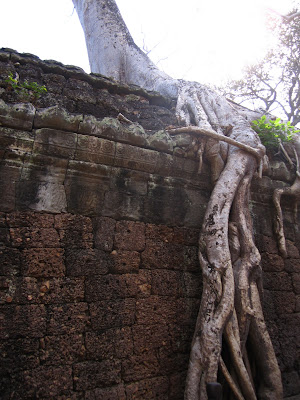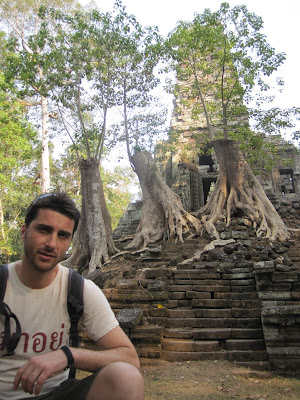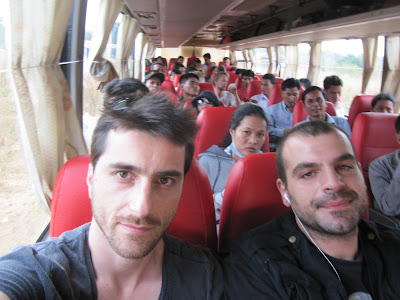Ratanakiri province is rural and pretty remote. It is one the most beautiful regions of Cambodia, with plenty to do for nature and culture lovers. It is located at the north east of the country, bordering with Laos at the north and Vietnam at the east. It is the home of a number of minority peoples like the Tombuons, Jarai, the Khmer Leu, all have their own languages, traditions and customs. They live in remote, shared ownership, self sustaining communities, far away from the modern way of life. Ratanakiri, 'the hill of the precious stones', (Ratanak=precious stones, kiri=hill), is known for its good quality stones extracted in the region's local mines as well as for its large production of rubber. We've seen kilometres of it lying next to the roads, drying in the sun. The town of Ban Lung is the regional capital where we stayed for some days. Surely there are fewer facilities here comparing to Phnom Penh, like limited food options, power cuts etc, but its outstanding beauty and the activities options available are certainly worth the long bus ride!
We rented a small bike and drove to nearby villages and to some natural beauties. Yeak Lom lake is located only 5 kms from Ban Lung. After about an hour looking for it, we discovered a beautiful, crater circle looking like lake surrounded by deep forest. The waters were crystal clear and there was a platform to dip in if you wish. The entry fee was towards the support of the Tombuon minority community who maintain the site and have some traditional bungalow hats on display, plus a few words about them. We visited some spectacular waterfalls, all of the attractions kindly managed by the community. Chaa Ong waterfall was the most beautiful, set in a jungle gorge you can clamber behind the waterfall and get sprayed by the water. Accidentally, I had a good fall, hurting myself trying to do exactly this..
More about Vietnam with the next post.. Exciting things already happening!
Be well and keep in touch! (and keep warm for those in the european winter)
Nektarios~
We rented a small bike and drove to nearby villages and to some natural beauties. Yeak Lom lake is located only 5 kms from Ban Lung. After about an hour looking for it, we discovered a beautiful, crater circle looking like lake surrounded by deep forest. The waters were crystal clear and there was a platform to dip in if you wish. The entry fee was towards the support of the Tombuon minority community who maintain the site and have some traditional bungalow hats on display, plus a few words about them. We visited some spectacular waterfalls, all of the attractions kindly managed by the community. Chaa Ong waterfall was the most beautiful, set in a jungle gorge you can clamber behind the waterfall and get sprayed by the water. Accidentally, I had a good fall, hurting myself trying to do exactly this..
Ratanakiri_Refuelling
Ratanakiri_Yeak Lom lake
Ratanakiri_Traditional Tombuon bungalows
Ratanakiri_Ka Tieng waterfall
Ratanakiri_Chaa Ong 'fall'
Ratanakiri_Kinchaan waterfall
We looked to get hold of some bigger bikes. This is in fact the best way to get around. But the roads are not as good as the sites. They are dusty red and we heard during the rainy season it turns to a mud looking something like a carrot soup. Considering there are plenty of bikes around, we managed to get two Honda 250cc to go a bit further and also have some fun! We visited Ta Veng, Voen Sai and some other regional villages, driving 180 kms in one day. We got lost few times but luckily not for too long. Spyros bike had some problems (as he was driving it as it was his own) but still we managed to get over it and continue. The owner wasn't very happy with the state we return the bikes back...
Ban Lung_It does indeed..
Ban Lung_Ready to go
Terres rouges de Ratanakiri
Getting dusty
Passing through Cha Ong village
Eat my dust..
Something is broken
Back to Ban Lung on a fake tan
Following this adrenaline-high activity, which we fully enjoyed, we thought to take it easy (and more environmental friendly) by hiring a guide and do some trekking to the Virachey national park. We arranged to stay overnight in the jungle so another local guide from the indigenous community joined us on the way. From Ban Lung, we got on a back of a bike to Ta Veng for 2 hours (punishing). From Ta Veng we got aboard on a boat and 3 hours later, through the Tonle San and O'Tabok rivers we arrived at the small village of Phum Yorn, at the boundary of the Virachey park. With our two guides, we embarked for a two day trekk and an overnight stay at a camp.
Tonle San river_Tribals are taking a dip
Down in the river
O'Tabok river_Getting rough, and wet
O'Tabok river_Time for a joint
Virachey_Setting up the camp
Virachey_Jungle premier inn
Virachey_Bamboo coffee mugs
Virachey is one of the largest protected areas in Cambodia and as they say it has never been fully explored. It is likely to foster a number of larger mammals such as tigers, deers (we've spotted one), leopards etc. We trekked through the jungle for two days on a circular route which ended back to Phum Yorn. The jungle was not as dense as in the Amazon but it was still difficult to walk (or crawl) through short height passes, ideal only for the heights of the locals.. Rubber and cashew nuts plantations in this region replace the jungle at an alarming rate but we were glad to see that within the park boundaries there were no signs of extensive agricultural activity.
There is an interesting story about the 'Jungle girl of Ratanakiri' which has actually attracted media from all over the world. In 1988, a nine year old girl, named Pnieng Rochum, disappeared in the jungle only to emerge back and reunite with her family in 2007. Traumatised and distant, she kept forever secret how she survived 18 years in the jungle. A kind of shocking story which put me thinking on what a human can do to survive, how we adapt to our environments and also how someone returns back to where he/she started, after all this. More on the story below.
Virachey_Our local guides
Virachey_Back to the river
O'Tabok_With ease..
O'Tabok_Reflections
We wanted to continue to Mondulkiri, a similar province to the south, but the condition of the road we wanted to travel through was very very bad, with the only other option to backtrack. After almost a week at the remotes we decided to leave the north and instead go to the south and explore a different Cambodia. We wanted to check the popular Cambodian seafront and enter Vietnam from the south. Sihanoukville was our next destination and considering we could very easily obtain our visa there and then enter into Vietnam, it was a good decision.
Sihanoukville was not too different to other beach towns. Busy, flooded with young western tourists, bars, clubs, restaurants and not so good street food. On top of it, the beach was full of rubbish. We did swim in the very warm waters of the gulf of Thailand and had some good snacks like crawfish with lemon (see below). We didn't do much, we've seen this quickly and after two days we got our bus tickets to the border.
Sihanoukville_Long Beach (long yes but no clean)
Sihanoukville_Hellenic relations
Sihanoukville_Long Beach
Sihanoukville_Fast food..
Sihanoukville_...craw fish that is
Sihanoukville_Cambodiaaa
After very few days in Sihanoukville, with our Vietnamese visa in hand, we decided to leave this beautiful country and its fun loving people behind. Personally, I felt kind of emotional (see picture below) when at the border. It is not the most sophisticated place on earth but the kindness of Khmer people, the temples of Angkor, the remotes of Ratanakiri and the beach lifestyle at the south, to my opinion assemble a beautiful country with past, present and future. It is still hard life for most of Cambodians but the country's positive future prospects are more and more obvious to every day life giving the people a, hopefully real, sense of hope and security with opportunities to flourish.
Sad to leave Cambodia
But happy for entering a new country...
Goooood morning Vietnam!
More about Vietnam with the next post.. Exciting things already happening!
Be well and keep in touch! (and keep warm for those in the european winter)
Nektarios~



















































































